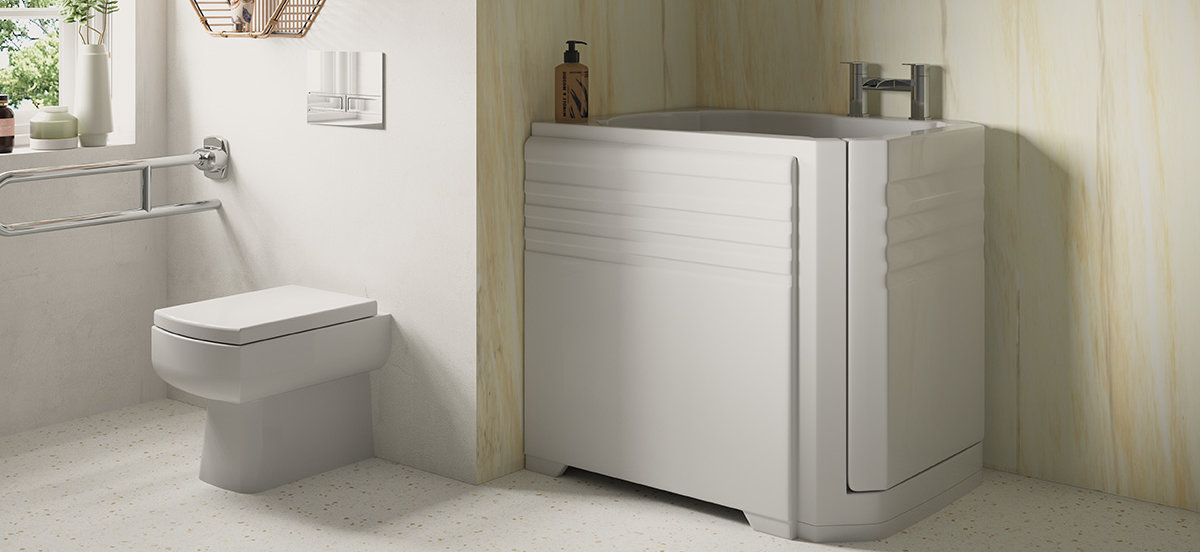What are the Benefits of Low Level Baths?

For many people, enjoying a long soak in the bath is one of life’s simple pleasures. What’s more, having a hot bath can provide various health benefits.
However, for older people and people with mobility issues, there can be many hazards to consider in the bathroom. One of the main hazards is the risk of injury when climbing in and out of the bath.
If you’re finding getting in and out of the bath hard or worried about slips and falls, you might want to consider bathroom adaptations such as installing a walk-in bath or shallow bath.
Are you affected by mobility issues when bathing?
Fill out the form in seconds and discover our full range of assisted bathing showers and baths.

Low level baths offer a relaxing and safe bathing experience for people with restricted mobility. Using a regular bath requires dexterity to lift your leg over the side and upper body strength to stand up from a sitting position. A low sided bath has a lower threshold, making them easier to step in and out of than a regular-height bathtub.
However, low level baths are not just suitable for people with restricted mobility. They can still be used by all members of the family.
We want to help you to continue enjoying bathing for many years to come. That’s why we offer a variety of easy-access baths, which will allow you to maintain your independence for longer. Read on to learn more about the benefits of installing a low bath in your bathroom.
What are low level baths?
In the UK, the most common size for a bathtub is 170 cm (length) x 70 cm (width). The bath height of a standard bathtub is approximately 20 inches (51 cm). Low baths are usually between 14 and 17 inches high (36 cm to 43 cm).
A standard-size bath with a height between 42 and 46 cm can hold around 192 litres of water, whereas low baths with a height of 38 cm can hold around 130 litres of water. This is a difference of 62 litres, so opting for a low-level bath makes it easy to save water.
What are the different types of shallow baths?
If you’re considering installing a low bath, you can consider a few different types of low baths. Here is an overview of the most popular types of low baths.
Standard low baths
A standard low-level bath is suitable for people without mobility issues. It is much easier to get in and out of a standard-size lower-height bath than a regular-height bathtub.
If you’re looking for a standard low-level bath, try searching for one with an internal depth of around 35 cm. These baths are usually available in various lengths, so it’s easy to find one that will fit in your bathroom.
Walk-in low baths
Walk-in low baths are much easier to get in and out of than standard baths. They can also help to minimise the risk of slipping over. Walk-in baths are the most accessible type of bath, so they’re perfect for older people and people with reduced mobility.
Once you’re safely inside the walk-in bath, you can fill it up with water. Walk-in baths from Premier Care in Bathing are fitted with thermostatic-controlled mixer taps, so it’s easy to get the temperature just right.
When you’ve finished enjoying your bath, simply drain the water away, open the door and get out. Some walk-in baths even feature heated seats, so there’s no need to worry about getting cold when you’re running the water or emptying your bath.
Walk-in baths are a great option if you want to enjoy the benefits of ultra-low-level access, but don’t want to compromise on the depth of the water in the bath. For example, the Assure Premier walk-in bath is twice as deep as a traditional bath, even though it is half the size.
Full-length walk-in baths with a side door
Walk-in baths are available in a range of designs. Some of these easy-access low baths have an inward-opening door at the side. To get into the bath, you just have to open the door and step in. There’s no need to worry about having to lift your leg over the side.
Compact walk-in baths with a door at the end
Walk-in baths with the door at the end tend to be more compact, so they fit easily into smaller bathrooms. The Cove walk-in bath has a contoured moulded backrest, armrests and an integral upright seat to offer optimum comfort and support. The door opens outward and there is a low-level access step, which makes it easy to get in and out of the bath.
Low baths with powered seats
If you want a full-length bath with a powered seat, the Empower walk-in chromotherapy bath is ideal. It has a side door and a powered seat, which will effortlessly lower you in and raise you out of the bath. The seat is even fitted with a battery backup for your peace of mind. Looking for something smaller? This bath is available in a shorter length that’s perfect for compact bathrooms.
How much do low level baths cost?
The cost of a low bath, as with their larger counterparts, varies depending on a few factors. Size, material, brand and installation costs all play a part in your overall outlay. And if you choose additional features such as power seating, Hydrovescent spa, or safety aids, this will have an impact on the price.
At Premier Care in Bathing, every bathroom installation is different and tailored to your personal needs, bathroom size, and the existing plumbing and electrics. However we offer a free, no-obligation consultation to assess your circumstances and requirements. Once this is complete, we can provide you with a detailed breakdown of the price.
The good news is, installing a low-level bath means you can make savings to your water bill in the long run, since they require smaller volumes of water to fill them up.
Things to Consider Before Choosing a Shallow Bath
- Who will be using the bath? Shallow baths are often safer options for children, older people, and people with mobility issues. However, you should check that the bath depth allows for comfortable bathing for all bath users.
- Space and Installation. Check the size and shape of your bathroom space carefully, including the location of any windows or doors. Find out if the existing waste pipes and plumbing is compatible, and consider whether you need to reinforce the floor to allow for the weight of the filled bath.
- Consider whether you want to opt for additional features such as built-in seating or grab bars. You should also check the slope of the backrest for comfort.
- Consider both the cost of the bath and any associated costs for installation and plumbing.
What are the main benefits of low baths?
1. Easier to step in and out of than standard baths
With a low bath, there’s no need to worry about lifting your legs over the tub's threshold, which helps reduce the risk of slips and falls.
2. Low baths offer a safe and comfortable bathing experience
For example, many low baths have anti-slip features included as standard. These features help to promote privacy and independence, as you don’t have to rely on someone to help you to get in and out of the bath.
3. Low baths can be easier to fit into compact bathrooms
Reconfiguring a bathroom can be tricky, so it’s always essential to plan the space carefully when choosing a bathtub.
4. Low baths have a smaller capacity than regular baths
This can help you to save money on your water and energy bills.
Do older people need low sided baths?
Not all older people need low sided baths, but they can be a helpful option to consider. The main benefits of low-side baths are:
- Reduced step-over bath height, which helps to reduce the risk of trips and falls
- Easier to maintain balance when getting in and out of the bath
- Less strength required to lift legs over the side of the bath
- Helps to maintain independence in bathing
- May allow longer use of a traditional bath setup
However, other solutions may be more appropriate, depending on the person’s needs.
Walk-in baths with a door can be better for people with significant mobility issues. You may also wish to consider wet rooms or level-access showers.
Bath lifts can be added to standard baths if you just need help with lowering and raising, whilst grab rails and non-slip mats can make regular baths safer for some people.
When deciding whether to install a low sided bath, you should consider the person’s current mobility level, their balance and strength, whether they have a caregiver to assist, their personal preference, the bathroom layout and space available, and what budget is available. You may also wish to consider whether their current level of mobility is likely to change in the future.
